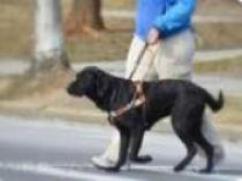
Basic Information:
According to the American's with Disabilities Amendment Act (ADAA), a service animal is defined as a guide dog, signal dog, or other animal individually trained to do work or perform tasks for the benefit of an individual with a disability. The task(s) must be directly related to a person's ability. Service animals are working animals (not pets) and are limited to dogs and miniature horses.
Service animals differ from companion animals (also referred to as comfort or assistant animals); companion animals do not qualify as service animals under the ADAA. Unlike service animals, companion animals are not trained to perform specific tasks for the benefit of an individual with a disability, though they certainly do provide comfort to the individual with the disability. Though not qualified as service animals, comfort or companion animals may be allowed as a reasonable accommodation in a dwelling under the Fair Housing Act (FHA) if several conditions are met, including: (1) the person has a disability; (2) the animal is necessary to afford the person with a disability an equal opportunity to use and enjoy the dwelling; and (3) there is an identifiable relationship or nexus between the disability and the assistance the animal provides. A letter or prescription from a qualified diagnostician can be required to bring a companion animal into a dwelling.
Inquiries About Service Dogs
It may not always be clear to you whether a dog is a service animal or a companion animal. Generally speaking, service animals (not companion animals) must be allowed to accompany people with disabilities in all areas of a facility where the public is normally allowed to go. If you have a question about whether or not a dog is a service animal, there are a limited number of (and specific) questions that you may ask. When it is not obvious, the questions you may ask regarding service animals are as follows:
- Is the dog a service animal required because of a disability?
- What work or task has the dog been trained to perform?
You may not inquire about the person's disability, require to see medical documentation, require the dog wear a special identification tag, require to see training documentation, or ask that the dog demonstrate the task it has been trained to perform.
Certification, Licensing, and Behavior
- Federal and State Law do not require registration, certification, or identification. Some counties in California may have a special service or companion animal registration, but this is not required
- Special harnesses, vests, or other items worn by a dog are unnecessary and do not prove that a dog is a service animal
- Both service and companion dogs must be licensed by the county just as any other dogs need licenses
- Service animals must be harnessed, leashed, or tethered, unless these devices interfere with the service animal's work or the individual's disability prevents their use
- The individual must maintain control of the animal through voice, signal, or other effective controls. If the dog is out of control, and the handler does not take effective action to control it, the person with the disability may be asked to remove the service animal from the premises

Service Animal Examples:
- Guiding people who are blind
- Alerting people who are deaf
- Pulling a wheelchair
- Alerting and protecting a person who is having a seizure
- Reminding a person with a mental illness to take medication
- Calming a person with Post Traumatic Stress Disorder (PTSD) during an anxiety attack
Etiquette Tips:
- Remember that the dog is working. Do not do anything to interrupt while it is performing its tasks
- Speak to the person. Do not aim distracting or rude noises at the dog
- Do not touch the service dog without asking for, and receiving, permission
- Do not offer food to the service dog
- Do not ask personal questions about the handler's disability or otherwise intrude on his or her privacy
Additional Resources: